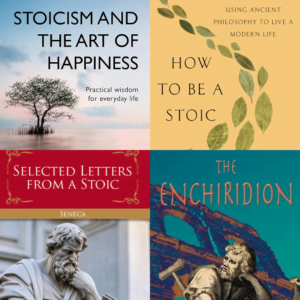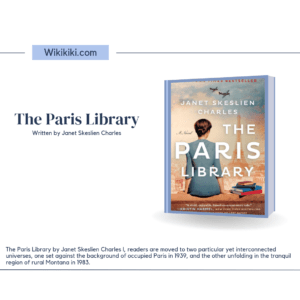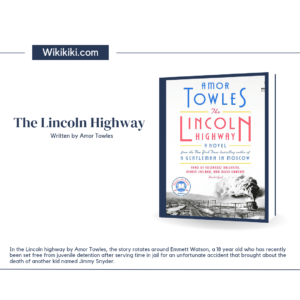
Stoic Philosophy Books
These top 5 Stoic philosophy books, these books give us an unique perspective on how to go through life’s challenges with resilience, equanimity, and joy. From Epictetus’s concise yet powerful manual, “The Enchiridion,” to Seneca’s epistolary reflections in “Letters from a Stoic,” these works provide practical guidance for living a life guided by reason and virtue. Massimo Pigliucci’s “How to Be a Stoic” shows us the ancient wisdom with modern life, while William B. Irvine’s “A Guide to the Good Life” invites readers to see the Stoicism as a path to lasting happiness. Donald Robertson’s “Stoicism and the Art of Happiness” goes deep into the psychological dimensions of Stoicism.
1. The Enchiridion

- Original title: Ἐγχειρίδιον Ἐπικτήτου
- Author: Epictetus
- Publication date: c. 125 CE
- Pages: 64 pages
- Original languages: Ancient Greek, Koine Greek
- Genre: Philosophy
“The Enchiridion,” a philosophical manual tributed to Epictetus, a former slave turned Stoic philosopher, gives us a guide to living a virtuous and fulfilling life in accordance with Stoic principles. Stoicism, a school of philosophy founded in ancient Greece addresses the importance of cultivating wisdom, resilience, and moral integrity to achieve inner peace and eudaimonia, or flourishing.
Epictetus, born around 55 CE in Hierapolis, Phrygia, had a challenging upbringing as a slave but later gained his freedom and devoted his life to teaching Stoic philosophy. His teachings, recorded by his student Arrian, provide practical advice on life’s challenges with wisdom, equanimity, and moral virtue.
Epictetus’ philosophy is the Stoic dichotomy of control, which distinguishes between what is within our power (our thoughts, opinions, desires, and actions) and what is not (external events, other people’s actions, and circumstances beyond our control). By focusing solely on what is within our control and accepting what is not, individuals can attain a state of inner freedom from the tyranny of external circumstances.
Epictetus urges readers to cultivate virtues such as courage, temperance, wisdom, and justice, recognizing that true happiness and fulfillment come from living a life of moral excellence. He says the importance of living in accordance with nature and reason aligning our actions with universal principles of justice, equality, and human dignity.
Throughout “The Enchiridion,” Epictetus provides practical guidance on various aspects of life, including dealing with adversity, managing emotions, and resilience. He encourages readers to face challenges as opportunities for growth and self-discovery.
Epictetus introduces the concept of “amor fati,” or the love of fate, which entails life’s events, both positive and negative with acceptance. By cultivating a mindset of acceptance and gratitude, individuals can find meaning and purpose in every aspect of their lives.
Epictetus advocated for universal principles of justice, equality, and human dignity, inspiring generations of readers with his wisdom and moral courage. “The Enchiridion” continues to resonate with modern readers seeking guidance on personal development, emotional resilience, and ethical decision-making in a complex world.
Facts About the Book “The Enchiridion”
- Epictetus was born a slave around 55 CE in Hierapolis, Phrygia, but later gained his freedom and became a Stoic philosopher.
- Despite his lack of formal education Epictetus’s teachings attracted numerous students, including Arrian, who later compiled his works into “The Enchiridion.”
- “The Enchiridion” is a condensed version of Epictetus’ teachings, while his more extensive work, the “Discourses,” offers deeper insights into Stoic philosophy.
- Epictetus’ ethical philosophy is rooted in the Stoic belief that virtue is the sole good and that living in accordance with nature and reason leads to eudaimonia.
- Epictetus’ teachings had an influence on later philosophical movements, including early Christianity and Renaissance humanism.
- “The Enchiridion” has been translated into numerous languages over the centuries, making Stoic wisdom accessible to a global audience.
- “The Enchiridion” remains a foundational text in Stoic philosophy giving practical advice for living a life of virtue, resilience, and inner peace.
2. Letters from a Stoic

- Author: Lucius Annaeus Seneca
- Publication date: c. 65 AD
- Original title: Ad Lucilium Epistulae Morales
- Genre: Philosophy
- Setting: Roman Empire
- Language: Latin
- Pages: 254 Pages
“Letters from a Stoic” by Seneca, a collection of philosophical letters addressed to his friend Lucilius, gives us insights into Stoic philosophy and practical wisdom for living a virtuous life. Through these letters, Seneca shares his thoughts on various aspects of life including the pursuit of wisdom, the acceptance of fate, the cultivation of inner peace, and the importance of time.
Seneca begins by introducing Lucilius to Stoic principles addresses the importance of virtue as the highest good. He tells that true happiness and fulfillment come from living in accordance with reason and moral integrity, rather than from external goods or pleasures. Seneca encourages Lucilius to strive for inner excellence.
Seneca’s philosophy is the notion of living in harmony with nature and accepting the inevitability of fate. He teaches Lucilius to face life’s challenges with equanimity and resilience viewing them as opportunities for growth and self-improvement.
Seneca also explores the concept of death as a natural and inevitable part of life, telling Lucilius to confront mortality with courage and acceptance. He also tells that the transient nature of existence can lead to a deeper appreciation of life and a greater sense of purpose. Seneca encourages Lucilius to make the most of each moment.
Throughout the letters, Seneca gives practical advice on how to cultivate inner peace amidst life’s uncertainties. He advises Lucilius to free himself from the tyranny of desires and to find contentment in simplicity and self-discipline. Seneca also discusses the importance of self-reflection, mindfulness, and ethical integrity in leading a meaningful and fulfilling life.
Seneca’s letters are filled with personal anecdotes, literary references, and practical examples, making Stoic philosophy accessible and relatable to everyday life. He draws upon his own experiences as a statesman, philosopher, and human being, illustrating the universal applicability of Stoic principles in going through the complexities of the human condition.
Facts About the Book “Letters from a Stoic”
- Seneca was born in Corduba (modern-day Córdoba, Spain) around 4 BCE, into a Roman family of equestrian rank.
- Seneca amassed considerable wealth through his various business ventures, including investments in silver mines.
- Seneca’s literary oeuvre encompassed a wide range of genres, including philosophical treatises, essays, tragedies, and letters, he was versatile as a writer and thinker.
- He served as a tutor and advisor to Nero, the infamous Roman emperor known for his tyrannical rule and extravagant lifestyle.
- Seneca’s stoic principles prompted him to advocate for moderation and temperance in the face of Nero’s excesses, leading to tensions between the two men.
- Following Nero’s ascension to power Seneca was accused of involvement in a conspiracy against the emperor and was ordered to take his own life.
- Seneca’s death by suicide, as commanded by Nero, epitomized his commitment to Stoic principles and his refusal to compromise his integrity in the face of tyranny.
- His philosophical works, including “Letters from a Stoic,” were rediscovered during the Renaissance and played a role in shaping the intellectual in Europe.
3. How to Be a Stoic: Using Ancient Philosophy to Live a Modern Life

- Author: Massimo Pigliucci
- Published: May 9, 2017 by Basic Books
- Original title: How to Be a Stoic
- Genre: Philosophy
- Pages: 288 pages
Massimo Pigliucci’s “How to Be a Stoic: Using Ancient Philosophy to Live a Modern Life” is a guide to applying Stoicism, an ancient philosophy to the challenges of modern life.
Pigliucci begins by introducing Stoicism its origins to ancient Greece and its development through Roman philosophers like Seneca, Epictetus, and Marcus Aurelius. He explains the core tenets of Stoicism, including the distinction between what’s within our control (our thoughts, actions, and attitudes) and what isn’t (external events), the importance of virtue as the highest good, and the practice of living in accordance with nature.
The book goes deep into the fundamental principles of Stoicism, such as understanding the dichotomy of control, practicing mindfulness, and cultivating resilience in the face of adversity. Pigliucci tells us the Stoic concept of “eudaimonia,” which is achieved through the development of character virtues like wisdom, courage, justice, and temperance.
Reflecting on misfortunes to develop gratitude for what one has and prepare oneself mentally for adversity. Mentally rehearsing potential obstacles and setbacks to build resilience and equanimity. Cultivating awareness and acceptance of the present moment rather than dwelling on the past or worrying about the future.
Keeping a journal to reflect on one’s thoughts, actions, and progress in living according to Stoic principles. Imagining oneself from a cosmic perspective to gain a sense of perspective and detachment from worldly concerns.
Throughout the book Pigliucci provides practical examples and real-life scenarios to illustrate how Stoic principles can be applied to various aspects of modern life, including relationships, work, and personal growth. He addresses common challenges such as anger, anxiety, and fear of failure, offering Stoic strategies for managing these emotions and maintaining inner peace.
Pigliucci tells that the criticisms and limitations of Stoicism such as its perceived indifference to social and political activism and its fostering emotional repression. He tells that Stoicism can be adapted and combined with insights from other philosophical traditions to address these concerns while retaining its core principles.
Facts About the Book “How to Be a Stoic: Using Ancient Philosophy to Live a Modern Life”
- The book is authored by Massimo Pigliucci, a philosopher and biologist known for his work in Stoicism, skepticism, and the philosophy of science.
- “How to Be a Stoic” was published on May 9, 2017.
- The book is as a practical guide to applying Stoic philosophy in modern life, insights and techniques for cultivating resilience, wisdom, and inner peace.
- Pigliucci draws on the teachings of classical Stoic philosophers such as Epictetus, Seneca, and Marcus Aurelius, while also incorporating insights from contemporary psychology and philosophy.
- Pigliucci writes in a clear and accessible style, making Stoic concepts and practices understandable and applicable to readers from different backgrounds.
- The book explores Stoic ethics and the importance of living in accordance with nature.
- Throughout the book, Pigliucci provides practical examples and real-life scenarios to illustrate how Stoic principles can be applied in various contexts, including relationships, work, and personal development.
- Pigliucci recommends keeping a Stoic journal as a means of reflecting on one’s thoughts, actions, and progress in living according to Stoic principles.
- The book incorporates insights from modern science, particularly psychology and neuroscience, to complement and enrich the ancient wisdom of Stoicism.
4. A Guide to the Good Life: The Ancient Art of Stoic Joy

- Originally published: 7 October 2008
- Author: William Braxton Irvine
- Pages: 336 Pages
- Genre: Philosophy
“A Guide to the Good Life: The Ancient Art of Stoic Joy” by William B. Irvine is a modern interpretation of Stoicism, an ancient Greek philosophy that teaches individuals how to live a fulfilling and meaningful life. Irvine, drawing from the works of Stoic philosophers such as Seneca, Epictetus, and Marcus Aurelius, presents Stoicism as a practical philosophy for living.
The book begins by providing an overview of Stoicism and its core principles says the importance of living in accordance with nature, accepting the things we cannot change, and focusing on what is within our control. Irvine explains that the ultimate goal of Stoicism is to achieve tranquility (ataraxia) and inner peace by cultivating virtues such as wisdom, courage, justice, and self-discipline.
Irvine discusses various Stoic techniques and practices that can help individuals cultivate resilience and emotional resilience. These include negative visualization, the practice of imagining worst-case scenarios to prepare oneself mentally for challenges, voluntary discomfort, deliberately exposing oneself to discomfort to build resilience and premeditation of adversity.
The book also explores Stoic techniques for managing negative emotions such as anger, anxiety, and fear. Stoicism teaches individuals to examine their beliefs and judgments about external events, recognize the irrationality of certain emotions, and cultivate a sense of detachment and perspective.
Irvine discusses the Stoic approach to desire and pleasure tells that true happiness comes from within and is not dependent on external circumstances or the fulfillment of desires. Stoics advocate for moderation, self-discipline, and gratitude as means of achieving lasting contentment and fulfillment.
Throughout the book, Irvine illustrates Stoic principles with anecdotes, examples from history, and practical exercises. He also addresses common misconceptions about Stoicism and highlights its relevance to contemporary issues such as stress and materialism.
Facts About the Book “A Guide to the Good Life: The Ancient Art of Stoic Joy”
- William B. Irvine is a professor of philosophy and a practicing Stoic himself, bringing both scholarly expertise and personal insight to the subject matter.
- Irvine provides practical guidance on how to apply Stoic principles in everyday life, offering actionable advice for cultivating inner peace and resilience.
- While rooted in ancient philosophy, Irvine’s interpretation of Stoicism is tailored to contemporary readers, making it relevant and relatable.
- The book incorporates various Stoic practices, such as negative visualization and premeditation of adversity, illustrating how these techniques can lead to greater happiness and fulfillment.
- The book includes anecdotes and examples from history and everyday life to illustrate Stoic principles and demonstrate their relevance.
- Irvine addresses common misconceptions about Stoicism and dispels myths that may deter readers from exploring the philosophy.
- The book has received positive reviews from readers and critics alike, praising its clarity, practicality, and effectiveness in imparting Stoic wisdom.
- Beyond philosophy enthusiasts the book has resonated with readers seeking practical guidance for living a more meaningful and fulfilling life.
- For those interested in delving deeper into Stoicism, Irvine provides recommendations for additional reading and resources.
- “A Guide to the Good Life” has been translated into multiple languages and has been released in various editions, including paperback, hardcover, and e-book formats.
- Irvine’s book has contributed to a growing community of individuals interested in Stoicism, fostering discussion and exchange of ideas online and in person.
5. Stoicism and the Art of Happiness

- Originally published: January 1, 2013
- Author: Donald J. Robertson
- Pages: 224 pages
- Published: Hodder Education
- Language: English
- Genre: Philosophy
“Stoicism and the Art of Happiness” by Donald Robertson is a practical guide to applying Stoic philosophy in modern life to achieve a greater sense of well-being and fulfillment. The book draws on the teachings of ancient Stoic philosophers such as Epictetus, Seneca, and Marcus Aurelius, presenting their principles in a context. Robertson breaks down these key concepts into actionable steps that readers can incorporate into their daily lives.
The book begins by providing an overview of Stoicism, its historical background, and its relevance in the modern world. One of the themes of Stoicism is the concept of the dichotomy of control, which teaches individuals to focus their energy on things they can influence while letting go of things beyond their control. Robertson illustrates how applying this principle can lead to greater emotional resilience and inner peace.
Another aspect of Stoicism discussed in the book is the practice of negative visualization, or imagining worst-case scenarios in order to appreciate what one has and prepare for adversity. By confronting fears and desires head-on, Stoics aim to develop a sense of gratitude.
Robertson also explores the Stoic virtues of wisdom, courage, justice, and temperance, saying their importance in leading a virtuous and fulfilling life. Through practical exercises and reflections, readers are encouraged to cultivate these virtues and apply them in their relationships, work, and daily challenges.
The book addresses common misconceptions about Stoicism, such as the belief that it promotes emotional detachment or passivity. Robertson clarifies that Stoicism is not about suppressing emotions but rather about cultivating a rational and balanced perspective allowing individuals to respond to situations with clarity and composure.
Facts About the Book “Stoicism and the Art of Happiness”
- Donald Robertson, the author, is not only a psychotherapist but also a leading expert in the application of Stoicism in modern psychotherapy.
- The book draws heavily on the teachings of ancient Stoic philosophers like Epictetus, Seneca, and Marcus Aurelius, but presents their ideas in a contemporary context.
- Unlike some misconceptions about Stoicism, Robertson clarifies that the philosophy does not advocate emotional detachment but rather encourages a rational and balanced approach to emotions.
- Stoicism and the Art of Happiness challenges readers to confront their fears and desires through negative visualization, a technique that may be unfamiliar but highly effective.
- The author addresses common misconceptions about Stoicism, such as the belief that it promotes passivity, and instead highlights its focus on personal agency and virtuous action.
- Robertson’s background as a psychotherapist adds depth to the book, as he explores how Stoicism can be integrated into modern therapeutic approaches.
- The book is a theoretical exploration of Stoicism a practical guide for personal development, offering tangible strategies for cultivating resilience and well-being.
- Robertson draws parallels between Stoic philosophy and concepts from cognitive-behavioral therapy (CBT), demonstrating how Stoic practices can complement modern psychological techniques.
- While Stoicism originated in ancient Greece and Rome, Robertson shows how its principles remain relevant and applicable in today’s fast-paced and often unpredictable world.
Also Read: Top 5 Classic Literature for Beginners


















